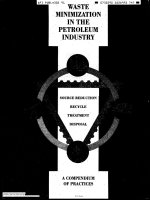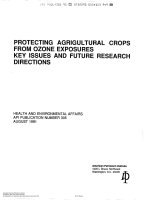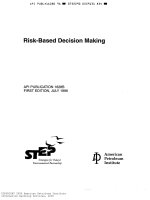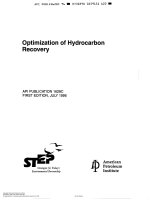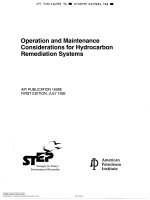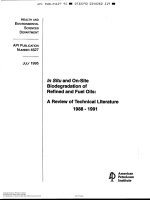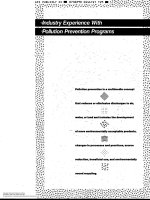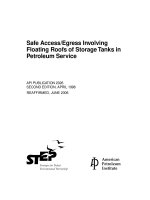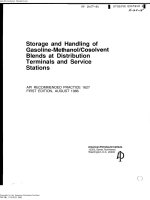Api publ 329 1994 scan (american petroleum institute)
Bạn đang xem bản rút gọn của tài liệu. Xem và tải ngay bản đầy đủ của tài liệu tại đây (4 MB, 163 trang )
~
A P I PUBLu329 9 4
~
~~
~
0732290 054397b 908
m
AND MANAGEMENT
--`,,-`-`,,`,,`,`,,`---
1
Copyright American Petroleum Institute
Provided by IHS under license with API
No reproduction or networking permitted without license from IHS
Not for Resale
9
9
1
A P I PUBLu329 9 4
0732290 0543977 844
Generation and Management
of Residual Materials
Petroleum Refining Performance
1991 Survey
Health and Environmental Affairs Department
API PUBLICATION NUMBER 329
PREPARED UNDER CONTRACT BY:
GAIL LEVINE
SUMMATIONS
WASHINGTON, D.C.
WENDALL CLARK
WC CONSULTANTS
HOPEWELL JUNCTION, N.Y.
MAY 1994
American
Petroleum
Institute
--`,,-`-`,,`,,`,`,,`---
Copyright American Petroleum Institute
Provided by IHS under license with API
No reproduction or networking permitted without license from IHS
Not for Resale
A P I PUBLlir329 9 4
0732290 0543978 780
=
FOREWORD
API PUBLICATIONS NECESSARILY ADDRESS PROBLEMS OF A GENERAL
NATURE. WITH RESPECT TO PARTICULAR CIRCUMSTANCES, LOCAL, STATE,
AND FEDERAL LAWS AND REGULATIONS SHOULD BE REVIEWED.
API IS NOT UNDERTAKINGTO MEET THE DUTIES OF EMPLOYERS, MANUFACTURERS, OR SUPPLIERS To WARN AND PROPERLY TRAIN AND EQUIP THEIR
EMPLOYEES, AND OTHERS EXPOSED, CONCERNING HEALTH AND SAFETY
RISKS AND PRECAUTIONS, NOR UNDERTAKING THEIR OBLIGATIONS UNDER
LOCAL, STATE, OR FEDERAL LAWS.
--`,,-`-`,,`,,`,`,,`---
NOTHING CONTAINED IN ANY API PUBLICATION IS TO BE CONSTRUED AS
GRANTING ANY RIGHT, BY IMPLICATION OR OTHERWISE, FOR THE MANUFACTURE, SALE, OR USE OF ANY METHOD, APPARATUS, OR PRODUCT COVERED BY LETTERS PATENT. NEITHER SHOULD ANYTHING CONTAINED IN
THE PUBLICATION BE CONSTRUED AS INSURING ANYONE AGAINST LIABILITY FOR INFRINGEMENT OF LETTERS PATENT.
Copyrighi Q 1994 American Petroleum Institute
i¡
Copyright American Petroleum Institute
Provided by IHS under license with API
No reproduction or networking permitted without license from IHS
Not for Resale
A P I PUBL*327 94
= 0732270 O543779
bLï W
ACKNOWLEDGMENTS
THE FOLLOWING PEOPLE ARE RECOGNIZED FOR THEIR CONTRIBUTIONS OF
TIME AND EXPERTISE DURING THIS STUDY AND IN THE PREPARATION OF
THIS REPORT
API STAFF CONTACTís)
Barbara Bush, Health and Environmental Affairs Department
Genevieve Laffly Murphy, Manufacturing, Distribution & Marketing
Tim Sampson, Manufacturing, Disuibution & Marketing
Wendy Sams, Information Services
John Wagner, Office of General Counsel
Paul Wakim, Statistics
Amita Gopinath, Statistics
MEMBERS OF THE REFINING SURVEY WORKGROUP:
--`,,-`-`,,`,,`,`,,`---
Mark Hopkins (Chairman), Chevron Corporation
Norbert Dee, National Petroleum Refiners Association
John Lemen, Texaco, Inc.
Richard Lindstrom, Ashland Petroleum Company
Mark Luce, Chevron Corporation
Mary Spearman, Ammo Corporation
< .
III
Copyright American Petroleum Institute
Provided by IHS under license with API
No reproduction or networking permitted without license from IHS
Not for Resale
~~
~
A P I P U B L X 3 2 9 94 W 0 7 3 2 2 9 0 0543980 339
PREFACE
To improve the quality of the data collected, and its relevance to current developments,
each year the American Pemleum Institute (APO reviews ail data collected in this survey,
and evaluates and revises, as necessary, the data collection forms and instructional materiais. Consistent with this ongoing effort to promote the integrity of the survey findings and
its utility to the industry, API has implemented a change in the terminology used in this survey. Beginning in 1990, API used the term “residual materials or residuals” instead of
“wastes and secondary materials.” This change in terminology reflects indusuy practice-the use of many of these materiais as feedstocksor for recycling, reuse, and reciamation. This change helps to reconcile the utilization of these materials in our indusuy
with the regulatory usage of the term “waste.”
--`,,-`-`,,`,,`,`,,`---
IV
Copyright American Petroleum Institute
Provided by IHS under license with API
No reproduction or networking permitted without license from IHS
Not for Resale
A P I PUBL*329 ỵ Y
0732290 05i13ỵưL 275
TABLE OF CONTENTS
Section
EXECUTIVE SUMMARY
........................................
e5-1
1.
INTRODUCTION
...........................................
1-1
2.
METHODOLOGY
..........................................
2-1
............................
2-1
.....................................
2-1
3. RESULTS . . . . . . . . . . . . . . . . . . . . . . . . . . . . . . . . . . . . . . . . . . . . . . . .
3-1
....................................
3-1
.......................
3-1
...............................
3-5
.............................
3-15
DATA COLLECTION FORMS
DATA ANALYSIS
RESPONSE RATE
RESPONDENT CHARACTERISTICS
RESIDUAL GENERATION
POLLUTION PREVENTION
..............
3-21
MANAGEMENT PRACTICES FOR RESIDUAL MATERIALS . . . . .
Recycling . . . . . . . . . . . . . . . . . . . . . . . . . . . . . . . . . . . . .
Treat ment . . . . . . . . . . . . . . . . . . . . . . . . . . . . . . . . . . . . .
Land Treatment . . . . . . . . . . . . . . . . . . . . . . . . . . . . . . . . .
Disposal . . . . . . . . . . . . . . . . . . . . . . . . . . . . . . . . . . . . . .
3-25
3-26
3-29
3-32
3-33
TOTAL QUANTITY OF RESIDUALS MANAGED
3-37
AQUEOUS MATERIALS . . . . . . . . . . . . . . . . . . . . . . . . . . . . . . .
3-37
Other Aqueous Residuals . . . . . . . . . . . . . . . . . . . . . . . . . .
TCLP Impact on Refining Wastewaters . . . . . . . . . . . . . . . . 3-37
4 . DISCUSSION
APPENDIX
APPENDIX
APPENDIX
APPENDIX
APPENDIX
..............................................
A .Questionnaire
B .Statistical Procedures
C .Summary of Pollution Prevention Initiatives (by Stream)
D .SAS Data Tables
E .Trend Data on Generation and Management Practices (by Stream)
--`,,-`-`,,`,,`,`,,`---
Copyright American Petroleum Institute
Provided by IHS under license with API
No reproduction or networking permitted without license from IHS
Not for Resale
4-1
0732290 0543982 101 M
A P I P U B L X 3 2 9 94
LIST OF TABLES
Table 1 .Refining Residual Streams
.......................................
Table 2 .Estimate of All Residuals Generated
by the U.S. Refining Industry: 1991
.............................
2-3
3-6
3-7
.........................
3-9
--`,,-`-`,,`,,`,`,,`---
Table 3 .Estimate of Residual Materials Generated
by the U.S. Refining Industry: 1991 . . . . . . . . . . . . . . . . . . . . . . . . . . . . .
Table 4 .Number of Refineries Reporting Each Stream
Table 5 .Covariance Data on Residual Generation Rates: 1987-1991
. . . . . . . . . . . . . 3-14
Table 6 .Number Refineries Reporting Each Pollution Prevention Activity
Table 7 .Summary of Pollution Prevention Activities
...........................
3-17
.....................
3-22
Table 8 .Estimates of Residual Materials Managed in 1991
Table 9 .Comparison of Residual Material Managed: 1991-1 987
. . . . . . . . . . . . . . . . . . 3-24
.................................
3-27
.Estimated Quantities of Recycled Materials . . . . . . . . . . . . . . . . . . . . . . . . .
3-28
..................................
3-29
.................................
3-29
..........................
3-31
..................................
3-32
......................
3-33
..................................
3-34
Table 10 .Summary of Recycling Practices
Table 11
. . . . . . . . . . . 3-15
Table 12 .Location of Recycling Activities
Table 13 .Summary of Treatment Methods
Table 14 .Estimated Quantities of Residuals Treated
Table 15 .Location of Treatment Activities
Table 16 .Estimated Quantities of Land Treated Residuals
Table 17 .Summary of Disposal Practices
Table 18 .Estimated Quantities of Wastes Eliminated by Disposal
Table 19 .Location of Disposal Activities
Copyright American Petroleum Institute
Provided by IHS under license with API
No reproduction or networking permitted without license from IHS
. . . . . . . . . . . . . . . . 3-35
...................................
Not for Resale
3-36
A P I PUBL*329 9 4
= 0732290 0543983 048
LIST OF FIGURES
....................
2-4
..................................
2-8
..........................
3-2
.............................
3-2
Figure A .Pollution Prevention Question and Code Categories
--`,,-`-`,,`,,`,`,,`---
Figure B .Statistical Estimation Procedures
Figure C .Number of Respondents by Capacity Group
Figure D .Distribution of Respondents by Location
Figure E .Distribution of Respondents by NPDES Complexity Classification
. . . . . . . . . . 3-3
Figure F .Distribution of Respondents by Refinery Age
.........................
3-3
Figure G .Distribution of Respondents by Sewer Type
..........................
3-4
Figure H .Residual Generation in the Petroleum Refining Industry: 1991 . 1987
Figure I .Trend Analysis Plot for API Separator Sludge
. . . . . . . 3-5
........................
Figure J .Generation Trends for FCCU and Hydroprocessing Catalysts
.............
3-11
..........
3-12
Figure K .Residual Generation Curves for Streams with Significant Trends
Figure L .Residual Generation Curves for Streams with Unexplained Variability
Figure M .Summary of Residual Management Practices for 1991
. . . . . . . 3-13
.................
Figure N .Longitudinal Comparison of Residual Management Practices: 1991-1987
Figure O .Techniques Used to Manage TC Hazardous Wastewater
Figure P .Generation of K-Wastes: Comparison of 1987 & 1991
Figure Q .Management of K-Wastes: 1987 .1991
Copyright American Petroleum Institute
Provided by IHS under license with API
No reproduction or networking permitted without license from IHS
3-25
. . . 3-26
. . . . . . . . . . . . . . . 3-37
. . . . . . . . . . . . . . . . . . . 4-2
.............................
Not for Resale
3-10
4-3
A P I PUBL*329 9 4
0732290 0543984 T 8 4
EXECUTIVE SUMMARY
In 1991, domestic refineries generated 14.8 million wet tons of residual materials. This
population estimate was based on the American Petroleum Institute's survey on residual
management practices. The survey has now amassed five years of consecutive data, with
each cycle representing at least 70 percent of the refining capacity. This analysis of the 1991
data includes information from APl's new question on pollution prevention activities, which
when combined with the five years of data, provides a better understanding of trends in
residual generation and management improvements.
The 14.8 million wet tons was the smallest quantity generated by the industry during the
survey. The differences between the 1991 quantity and all previous years were statistically
significant, even though the 16 million wet tons estimated for 1987-1989 were only slightly
larger.
API makes a distinction between two classes of materials: there are 29 specific Residual
Streams and another group of miscellaneous dilute materials, Other Aqueous Residuals.
As illustrated below, Other Aqueous Residuals constitute the largest quantity of residuals.
Rather than representing a typical industry generation pattern, however, these materials are
generated by only several refineries that have deep-well injection capability. As displayed, the
quantity of these Other Aqueous Residuals dropped in 1991.
Generation of Residual Streams and Other Aqueous Reslduals: 1987-1991
Millions
h
1
..
12
10
8
6
4
2
ov
I
1987
/
1989
1990
Residual Streams
/
/
/
/
1988
1991
Other Aqueous Resids
Reductions were also observed in 1991 for several of the specific streams that make up the
Residual Streams category. These include Pond sediments and Contaminated soils that
dropped from the peak quantities reported in 1990, and the K-Wastes which have shown a
more systematic downward trend over the survey period. The estimated quantity for several
streams increased in 1991, including Spent caustics and the newly reported class of primary
sludges (F037 and F038 listed wastes).
ES-1
--`,,-`-`,,`,,`,`,,`---
Copyright American Petroleum Institute
Provided by IHS under license with API
No reproduction or networking permitted without license from IHS
Not for Resale
The trend analysis revealed distinct generation patterns for certain streams. For some, such
as Spent FCCU and hydroprocessing catalysts, generation remained consistent over time.
This would be expected since these streams are related to throughput. For others, like Spent
caustics, the generation quantities have increased. It is believed that this reflects improved
and more consistent reporting over the course of the survey.
Another grouping of streams was based on the occurrence of pronounced, periodic spikes
such as the peak quantities of pond sediments and contaminated soils generated in 1990. In
these instances, larger quantities of waste equate to environmental progress, such as site
remediation and construction of new process and residual management units.
--`,,-`-`,,`,,`,`,,`---
API separator sludge and DAF float belong to a group of streams where progressively smaller
quantities were generated over time. These reductions reflect the industry’s concerted effort
to minimize generation of these streams, largely through pollution prevention activities.
Indeed, refiners reported that a variety of pollution prevention activities accounted for a
reduction of over 300 thousand wet tons of API separator sludge and DAF float. (Note that
unlike the estimates for the population of refineries that are presented in this report, the
pollution prevention information are not U.S. totals and only represent the amount reported by
those refineries that responded to the pollution prevention question).
APl’s survey is the only ongoing effort to document pollution prevention activities across an
entire segment of industry. In 1991, approximately half of the refiners responded to the
pollution prevention question indicating that they had performed at least one source reduction
or beneficial recycling activity. This accounted for 715 thousand wet tons of material. Pollution
prevention activities were reported for 26 of the 30 residual streams. In an effort to promote
technology transfer, API includes narrative summaries of the various methods used with each
stream in its report.
In addition to these pollution prevention achievements, 1991 also witnessed improvements in
how the refining industry manages non-aqueous residual materials. This is graphically
depicted below, with the quantities handled by each technique on the left and a percentage
display on the right.
Summary of Residual Management ‘Practices: 1987-1991
Wei T a
40
30
20
10
O
ES-2
Copyright American Petroleum Institute
Provided by IHS under license with API
No reproduction or networking permitted without license from IHS
Not for Resale
.... ... .. ..... .....
API PUBLX329 9 4
= 0732290 0543986 8 5 7 W
As illustrated by the graph on the left, the peak quantities generated in 1990 affected some of
the prevailing patterns or trends in residual management. For example, the industry’s use of
land treatment has diminished over the five year period, although 1990 witnessed a temporary
increase when this technology was used to handle the residuals that resulted from one-time
constuction and site remediation activities. Recycling, the most preferred handling technique in
the waste management hierarchy, has increased since 1987, although 1991 saw a slight drop
from the high noted in 1990. Treatment, which was no! heavily relied on to manage the peak
quantities generated in 1990, remained fairly constant, as did disposal.
The reduction in the use of land treatment and the increases in recycling reflect some of the
management improvements instituted to meet the Resource Conservation and Recovery Act
(RCRA) land disposal restrictions. As noted above, however, pollution prevention measures
implemented by the industry significantly reduced generation of the K-wastes making
compliance achievable. Thus, pollution prevention should be recognized as a crucial
component of industry and regulatory plans to improve management of residual materials.
ES-3
--`,,-`-`,,`,,`,`,,`---
Copyright American Petroleum Institute
Provided by IHS under license with API
No reproduction or networking permitted without license from IHS
Not for Resale
A P I PUBL*329 94
m
0732290 0543987 793
m
Section 1
INTRODUCTION
At this five-year mark, it seems appropriate to look back on the survey effort, and then, with
this overview, proceed with the findings of the expanded analysis of the current data.
The five-year cycle for the survey was set for several reasons:
to assure the availability of sufficient data to reliably characterize residual
generation and management practices;
to temper the interpretation of fluctuations observed between survey cycles; and
0
to demonstrate the industry's commitment to voluntary efforts to monitor its
environmental performance.
Reflecting some pragmatic concerns voiced by the refiners during the design phase of the
study, these considerations have served as guideposts for the study. Refiners initially
cautioned that trends would be difficult to determine because of the unique considerations of
each refinery. Specifically, there are a variety of factors that influence residual generation:
differences in the configurations of refineries, their age and capital improvements, geographic
location, crude characteristics and product slates. Because of the multiplicity of interactions
among these factors, refiners believe that efforts to control or influence residual management
practices must give deference to site-specific considerations.
This five-year framework has likely enhanced the quality and utility of the data beyond the
original plans for the survey. It has allowed successive refinements to be made in the survey
questionnaire and data collection procedures, which, in turn, have improved the quality of the
data collected, and the understanding of the data.
It is also important to note that there have been significant changes in the regulatory climate
during the study interval. The survey was initiated in 1988, the height of the "command and
control" approach to waste regulation, when more stringent prohibitions were being
promulgated under the Resource Conservation and Recovery Act (RCRA). Waste Minimization
was then the favored strategy for addressing waste generation.
By 1991, many of the proscriptive rules had become effective: there were three new streams
listed as hazardous under RCRA and the new Toxicity Characteristic; land disposal
restrictions precluded placement of hazardous wastes on the land without prior treatment to
the Best Demonstrated Available Technology (BDAT); and Source Reduction was the
preferred strategy for controlling waste generation.
1-1
Copyright American Petroleum Institute
Provided by IHS under license with API
No reproduction or networking permitted without license from IHS
Not for Resale
--`,,-`-`,,`,,`,`,,`---
With this report for calendar year 1991, the American Petroleum Institute (API) has achieved
its goal of collecting at least five years of data on residual material managed by domestic
petroleum refineries. There are no plans to end this survey effort with this report; to the
contrary, API is already collecting data for 1992 and 1993.
A P I PUBL*329 94
m
0732290 0543988 b2T
m
As this report is published, a next generation of regulations is being contemplated: emphasis
is placed on a more reasoned and holistic approach, wherein media-specific strategies are
integrated, and site-specific flexibility is being discussed. Pollution prevention, which
encompasses waste minimization and source reduction, is now the accepted term for waste
management improvements.
The petroleum industry’s environmental concerns, compliance strategies and management
approaches have likewise evolved over the study period. Indeed, this survey is now part of a
larger effort by the industry to publicly account for its environmental practices. The STEP
program--a Strategies for Today’s Environmental Partnership--was developed to implement
APl’s guiding principles in 1991. STEP calls for a series of data collection efforts to enable a
self-assessment of the industry’s environmental practices.
Because the survey always included a reporting component, API viewed the effort as fulfilling
its responsibility to promote technology transfer--one of the tenets of an effective waste
minimization program. The survey reports, with the descriptive summaries of innovative
activities undertaken by refiners, served as a vehicle to disseminate this information.
A secondary benefit, not recognized at the outset, is that the survey instrument itself has
become an important tool for the industry, providing direct technical guidance to refiners on
measuring residuals generated and standardizing accounting of their subsequent
management.
And again, this effort paved the way for other research. The success of the survey helped the
industry to mount several projects that promote innovative techniques, such as the design of a
new crude unit that minimizes multi-media releases.
The availability of this survey data has already helped the industry to engage in more
meaningful dialogue about its practices with community and special interest groups, local and
Federal regulatory agencies. API anticipates that these activities will increase with the
issuance of this report and the industry’s more comprehensive analysis of the data on the
residual generation patterns, and the quantitative profile of how the industry is meeting the
management challenges of the nineties.
1-2
--`,,-`-`,,`,,`,`,,`---
Copyright American Petroleum Institute
Provided by IHS under license with API
No reproduction or networking permitted without license from IHS
Not for Resale
A P I PUBL*329 9 4 W 0732290 0543989 566 W
Section 2
METHODOLOGY
For 1991, as with all previous years, the survey employed a census design. A listing of the
183 operating refineries was developed from the Department of Energy's 7991 Petroleum
Supply Annual. Survey materials were mailed in August, 1992--one month earlier than the
typical September mailing date. As with previous years, the six week interval allowed for form
completion was extended to increase he response rate. Contact was maintained with all
refineries during the field administratio , with three follow-up calls placed to refineries to
encourage response and through a "HELP-line" staffed by a refining expert.
\
The questionnaire was revised for 1991 to reflect regulatory changes that affected the
classification of refining residuals and to gather information on pollution prevention. The
analytic procedures were also updated to improve the estimation for 1991, and to expand the
analysis of the data beyond the simple summary statistics previously generated. The sections
that follow describe the revisions of data collection forms and of the analytic procedures used
to create the population estimates.
DATA COLLECTION FORMS
APl's survey questionnaire for 1991 included nine short-answer questions focused on refinery
characteristics and a series of "data sheets"- one-page forms that collect empirical
information on the quantities of residual materials' generated and how they are managed.
There were 30 data sheets for 1991. On each, "inputs" of residual materials are balanced
against "outputs." Inputs include the Quantities Generated plus Treatment Additives and the
Net Removed from Storage (Le., the total amount of material removed from storage minus the
amount placed into storage) and constitute the "Total Quantity Managed." As illustrated below,
this is balanced according to the waste management hierarchy by the quantities of waste
recycled, treated, or disposed.
Quantity Generated iTreatment Additives + Net From Storage = Total Quantlty Managed
Total Quantity Managed = Quantity Recycled + Quantity Treated + Quantity Disposed
API used a two-page format for the data sheets in 1991. Rather than provide a "Code sheet"
to which refiners had to refer for the various recycle, treatment and disposal codes, these
codes were printed on the back of the preceding page in a different color. Survey participants
no longer had to flip back and forth to code management practices, an activity that increased
the respondent burden, and increased the likelihood of data coding errors.
'
Beginning with publication of the Final Report for 1990, API has used the term "residual materials
or residuals" to refer to what had previously been called "wastes and secondary materials." This
change in terminology reflects industry practices--theuse of many of these materials as feedstocks or
for recycling, reuse, and reclamation. This change helps to reconcile the utilization of these materials in
the petroleum industry with the regulatory usage of the term "waste."
2-1
--`,,-`-`,,`,,`,`,,`---
Copyright American Petroleum Institute
Provided by IHS under license with API
No reproduction or networking permitted without license from IHS
Not for Resale
A P I PUBL+329 94
m 0732270 0543990
288
m
The questionnaire was provided in both hard copy form and on an automated disk, written
using Clipper, a commercially available compiler for dBase. A copy of the data collection form
is presented in Appendix A.
Several changes in the forms were implemented for 1991:
o
b
new questions on the impact of the Toxicity Characteristic (TC) were added to
the short answer questions about the refinery characteristics;
the listing of refinery streams was modified to incorporate the newly listed
"F wastes" under RCRA.
a Pollution Prevention question was added to each data sheet.
Two questions were developed on the Toxicity Characterlstlc. The first requested
information on the amount of wastewater that failed the Toxicity Characteristic Leachate
Procedure and its disposition. The second question focused on the amount of residuals
considered "solid waste" under RCRA that was characteristically hazardous. (See Questions 8
and 9 in Appendix A.)
In 1990, three new streams were designated as listed hazardous wastes under RCRA:
b
b
o
F037 - Primary sludge (Gravitational separation)
F038 - Primary sludge (Physicakhemical separation)
F039 - TSD Leachate
Data on these residuals had previously been captured by the survey, aggregated with other
residual materials. Consequently, in addition to adding these three streams to the existing
listing of 28 streams, all references to these residuals were deleted from the description of
other residuals. Because Other Separator Sludges (API code 105) was now subsumed by
F037 and F038, there remained a total of 30 waste streams. This listing of streams is
presented in Table 1.
As the footnote to Table 1 suggests, the intent of the survey was to capture information on
only residual materials-not wastewater that is directly treated and discharged under a
NPDES permit or discharged to a POTW.
2-2
--`,,-`-`,,`,,`,`,,`---
Copyright American Petroleum Institute
Provided by IHS under license with API
No reproduction or networking permitted without license from IHS
Not for Resale
~~
A P I PUBL*329 94
0'732290 0543991 114
Table 1
Refining Residual Streams
Constituents
Aqueous residuals
Biomass
High pHAow pH waters
Oil contaminated waters (not Wastewaters)'
Spent Stríord solution
Spent sulfide solution
TSD Leachate (F039)"'
Other aqueous residuals NOS"*
Chemicals/inorganic residuals
Spent acids
Spent caustics
Residual amines
Other inorganic residuals NOS"
Contaminated soils/solids
Contaminated soils/solids
Heat exchanger bundle cleaning sludge"'
Residual coke/carbon/charcoal
Residual/waste suifur
Other contaminated solids NOS**
Oily sludges/other organic residuals
API separator sludge**'
DAF float"'
Leaded tank bottoms***
Nonleaded tank bottoms
Pond sediments
Primary sludge (F037)'*'
Primary sludge (F038)"'
Slop oil emulsion solids***
Waste oils/spent solvents
Other oily sludges/organic residuals NOS**
Spent catalysts
Fluid cracking catalyst
Hydroprocessing catalyst
Other spent catalysts NOS"
Other residuals
Other wastes NOS"
--`,,-`-`,,`,,`,`,,`---
Category
Does not include NPDES or POTW wastewaters.
** Not otherwise specified.
'** RCRA-listed hazardous wastes for petroleum refining.
The new pollution prevention question replaced the questions previously used to capture
information on source reduction and resource recovery. Each year retiners have had difficulty
applying the definition of source reduction to industry practices, in particular, distinguishing
these from other improvements in residual management practices. To enable refiners to
report beneficial recycle of residual materials out-of-process on-site or by other users off-site,
in 1990 API developed a new question to obtain information OR Resource Recovery activities.
This question was placed immediately before the Source Reduction question, in an effort to
force respondents to make a distinction between various beneficial activities, some of which
are considered to be waste minimization, and others that are regarded as source reduction.
2-3
Copyright American Petroleum Institute
Provided by IHS under license with API
No reproduction or networking permitted without license from IHS
Not for Resale
A P I PUBL*329 94
m 0732290 0543992 O50 m
This strategy improved the reporting of this information, but did not totally resolve activity
classification errors.
API believes that source reduction and beneficial recycling of materials are both critical
elements in industry efforts to manage residuals. Moreover, APl’s survey experience
suggests that the distinction between the two, or prioritization of one over the other, is not
necessarily meaningful to refiners. Rather than perpetuate this somewhat arbitrary distinction,
and as part of its continued effort to increase refiners’ awareness of these activities and
improve the quality of the data collected, API combined the two questions. The reporting
format previously used for the source reduction question was retained, but the activity
categories were expanded to include four new recycle codes. The question was labeled
Pollution Prevention since this concept embraces both source reduction and beneficial
recycling. Placed on each data sheet where refiners are asked to perform quantitative
calculations, spaces were provided for up to three activities. The pollution prevention activity
codes were placed on the facing worksheet. Both the question and codes are presented in
Figure A.
Figure A
Pollution Prevention Question and Code Categories
POLLUTION PREVENTION
--`,,-`-`,,`,,`,`,,`---
Did your refinery initiate any activities, change any practices or modify any equipment that
DECREASED the amount of this waste stream generated or requiring disposal capacity in 1991?
o
0
No
Yes - Enter amount reduced,
wet tons, circle the appropriate waste prevention
method code below and provide a brief description of the method used:
Code
Description:
1 2 3 4 5
6 7 8 9 1 0
Activity 1. Year 19--
POLLUTION PREVENTION CODES
1 = Equipment or Technology Modifications
2 = Procedure Modifications
3 = Reformulation or Design of Products
4 = Substitution of Raw Materials
5 = Improved Housekeeping, Training, or Inventory Control
IN-PROCESS RECYCLE
6 = In refining process units (e.g., crude unit; coker; desalter)
7 = Recovering oil (& dewatering) by filter pressingkentrifugation
j
8 = Other recycle
OUT-OF-PROCESSRECYCLE
9 = Reuse/reclamation
10 = Other
2-4
Copyright American Petroleum Institute
Provided by IHS under license with API
No reproduction or networking permitted without license from IHS
Not for Resale
API PUBLr329 94 m 0732290 0543773 T77 m
DATA ANALYSIS
The data verification and estimation procedures for 1991 were similar to those used
previously. Data verification included 28 automated consistency checks for the variables on
each data sheet, as well as final range checks across respondents and comparisons with the
data previously submitted by the respective refinery. In cases that were identified in the edit,
the data were verified by direct contact with the facilities to ensure its accuracy.
--`,,-`-`,,`,,`,`,,`---
For each survey year, API develops an estimate of residuals generated by the entire industry
based upon information submitted by survey respondents.* Implicit in this approach are the
assumptions that the factor(s) influencing waste generation for respondents do not differ from
those for non-respondents.
Regression analysis was used to estimate the residual quantity generated by the industry. In
previous years, the regression model was based on all residual streams. For 1991, Other
Aqueous Residuals NOS (Not Otherwise Specified) was not included in the model because it
was the stream with the most aberrant responses. That is, few refineries report generating
this stream, but those who did, reported extremely large quantities that were disposed by
injection in wells. In all previous cycles, these cases had been identified as statistical outliers
and were handled differently during model development. However, in 1991, this stream was
handled separately throughout the modelling and estimation procedure as described in
Appendix B.
Data on refinery characteristics (e.g., operating capacity, age, sewer system) was analyzed to
evaluate the effect of the different factors on residual generation at a refinery. Scatter-plots
were used to explore relationships between residual generation and the factors thought to be
affecting it. Correlation analysis was performed and as in previous years, operating capacity
of a refinery was found to be most significantly correlated with residual generation.
Scatter-plots were also used to quantify the form of capacity that best captured its relationship
with residual generated. Regression models using different forms of capacity and residual
quantity generated were evaluated based on performance criteria like R2 and Root Mean
Squared Error. Evaluation was also based on how closely model assumptions on normality of
residuals and homogenous variagce of residuals were followed.
In 1991, six outliers were identified during the modelling procedure. Outliers are influential
observations that do not follow the general trend of the data and thus deleting them from the
model results in a better fit. The six outliers were excluded only from the model used for
estimating residual quantity generated by the non-respondents but were included at all other
stages of the estimation procedure.
After examining regression models, scatter plots and correlations, it was found that the best
relationship was between capacity and square root of total residual quantity generated at a
refinery. Therefore, the regression model used for 1991 was of the form:
A more technical summary of the estimation procedures is included in Appendix B.
2-5
Copyright American Petroleum Institute
Provided by IHS under license with API
No reproduction or networking permitted without license from IHS
Not for Resale
A P I PUBL*329 94 W 0732290 0543994 923 W
JTotal Generated Quantity = a + b( Cupcity)
or
Total Generated Quantity
= [a +
b(Capacity)l2
where a and b were estimated based on the data from the 107 responding refineries that were
not statistical outliers. Because of the square-root transformation, this model yields a biased
estimate of the residual quantity generated and a bias correction factor has to be applied.
The regression model was then used to estimate the total residual generated by each nonrespondent by (1) inputting its capacity into the model; (2) squaring the result; and, (3)
applying a bias correction factor so that the final estimate is unbiased.
amount of residual materials generated in 1991 for all (1 83) of the U.S.
To estimate the
refineries, estimates for the 70 non-respondent refineries were combined with: 1) the data
obtained from the 113 survey participants (including the six outlier facilities); and 2) the
quantity of Other Aqueous Residuals estimated for the population of refineries. This is
illustrated in the first row of the flow chart presented in Figure B. All residual generation and
management data shown in this report are estimates for all 183 refineries.
After deriving the total quantity of generated residual, calculations were performed to estimate
the generation quantities for each of the 29 residual streams. A summary of the procedure
used is as follows:
The total reported quantity of residuals for each stream was determined
by summing the generated quantities from all respondents.
2)
The relative contribution of each stream to the total reported quantity
was obtained by dividing the individual residual stream generation
quantity calculated in (1) by the total quantity of residuals for all 29
streams generated by respondents.
3)
Each proportion calculated in (2) was multiplied by the total estimated
residual quantity for all non-respondents to get residual quantities, by stream,
for non-respondents.
4)
Estimated generated quantity for a stream was obtained by summing the
corresponding respondent and non-respondent quantities from (1) and (3). This
is depicted in the second row of the flow chart.
--`,,-`-`,,`,,`,`,,`---
1)
To obtain the managed quantity of residuals, the proportion of treatment additives and net
quantity from storage to generated quantity in each stream was calculated. (Shown in the third
row of Figure B.) These proportions were then multiplied by the non-respondent generated
quantity for a stream to get estimated amounts of treatment additives and net from storage.
Thus, the managed quantity of residuals was calculated by summing (a) generated quantity,
2-6
Copyright American Petroleum Institute
Provided by IHS under license with API
No reproduction or networking permitted without license from IHS
Not for Resale
A P I PUBL*329 94
= 0’732290 0543995 8bT W
--`,,-`-`,,`,,`,`,,`---
(b) treatment additives and (c) net from storage for respondents and non-respondents. A
detailed explanation of the above procedure and that used for estimating recycled, treated and
disposed amounts is given in Appendix B. The last four rows of the flow chart illustrate how
the management estimations are performed.
Also, variances for the total estimated generated quantity and individual stream quantities
were calculated. Using these variances, approximate 95% confidence intervals for the
individual stream quantities were obtained.
Since 1991 is the fifth year of the Refining Residuals survey, longitudinal data was available to
conduct a trend analysis. For each stream, the estimated generated quantity and its 95%
confidence interval was plotted for all years. Significant differences in residual quantities over
years can be evaluated by determining any overlap in the confidence intervals from one year
to another.
2-7
Copyright American Petroleum Institute
Provided by IHS under license with API
No reproduction or networking permitted without license from IHS
Not for Resale
A P I PUBL*329 94
r------
m 0732290
0 5 4 3 ỵ î b 7Tb
m
r
r-
1
--
Ir - - I
r-
1_- r
r
i
r------- 1
i
,
i
i
--`,,-`-`,,`,,`,`,,`---
Ø-
r--i
Copyright American Petroleum Institute
Provided by IHS under license with API
No reproduction or networking permitted without license from IHS
Not for Resale
A P I P U B L X 3 2 9 94 D 0732290 0543997 632
=
Section 3
RESULTS
RESPONSE RATE
In 1991, 113 refineries participated in the survey. This represented 62 percent of the
population of 183 refineries, and accounted for 73 percent of the domestic crude refining
capacity. This was the second highest response obtained, and continues the industry’s
achievement of at least 70 percent of the refining capacity participating in each survey cycle.
Of the 113 respondents, 70 had participated in all five years, which provided a sizeable cohort
for covariance calculations. This was, however, 14 less than the 84 that had participated in all
of the previous four surveys. The turnover in participants--particularly in this group of
refineries that regularly respond-serves as a reminder that the population of refineries varies
from year to year. Even though the total number of operating facilities has remained 183 for
the last few years, each year there have been some closings and reactivations. In 1991, six
refineries owned by majors, five of which had participated in each previous survey, either
closed, converted to asphalt plants or marketing terminals (Le., no longer met the inclusion
criteria for this survey) or were sold. During the year, five other refineries were reactivated.
As will be seen in the following discussion of refinery characteristics, the overall turnover of
approximately 22 percent exerted some subtle, but detectable changes on the sample
characteristics.
RESPONDENT CHARACTERISTICS
The 113 respondents reported an operating capacity of 12,073,851 barrels per stream day
(b/sd). The total amount of crude charged in 1991 was 3,848 million barrels.
The profile of respondents by capacity class was very similar to that observed previously (See
Figure C). There was an increase in the number of small refineries participating in the survey.
Also, the distribution of operating refineries shifted slightly from 1990, with fewer in the 51-100
b/sd class, and several more in the 100-200 b/sd group.
3-1
--`,,-`-`,,`,,`,`,,`---
Copyright American Petroleum Institute
Provided by IHS under license with API
No reproduction or networking permitted without license from IHS
Not for Resale
A P I PUBLX329 9 4
0732290 O543998 579
=
Figure C
Number of Respondents by Capacity Group
# REFINERIES
70 1
60
c
=RESPowTS
POPULATION
ISM
IOQ)
CAPACITY CLASSES B/SD
The distribution of refineries by location changed in 1991, departing from the direct
relationship previously noted between the total number of refineries in each U.S. Department
of Energy’s Petroleum Administration for Defense (PAD) district and the number of refineries
participating in each region. As shown in Figure D, the 34 respondents from PAD II (the third
largest district) equalled the 34 refineries in the Texas/Louisiana region (PAD ill),the district
with the most operating refineries. The number of participants in PAD V increased by two,
while one less refinery responded from PAD IV.
Figure D
Distribution of Respondents by Location
3-2
--`,,-`-`,,`,,`,`,,`---
Copyright American Petroleum Institute
Provided by IHS under license with API
No reproduction or networking permitted without license from IHS
Not for Resale
API PUBL*327 74 W 0732270 05Y3977 405 m
API uses the NPDES permit classifications to categorize the complexity of the refineries.
Consistent with overall distribution of refineries, cracking facilities continued to predominate in
1991 (See Figure E). Several more topping facilities responded this year, a likely occurrence
when one considers the increase in participation observed in the smallest capacity class.
Figure E
Distribution of Respondents by NPDES Complexity Classification
..
60
.
50
40
30
.. ..
20
10
"
n
TOPPING
CRACKING
PETROCHEMICAL
LUBE
INTEGRATED
NPDES Comolexitv Classification
The data collected on the age of the refineries are presented in Figure F. The subtle
differences across survey years reflect the turnover in the respondent sample. The largest
between-year differences occur in refineries built between 1971-1980, relatively new facilities.
The largest group continues to be the oldest, approaching 70 years in operation, since they
were built before 1925.
Figure F
Distribution of Respondents by Refinery Age
Year Operations Started
>1980 -
mJ
--`,,-`-`,,`,,`,`,,`---
1971-1980
I
1951-1 960
1941-1950
f$$w
1 925-1 940
cl 925
O
20
10
30
Number of Facilities
3-3
Copyright American Petroleum Institute
Provided by IHS under license with API
No reproduction or networking permitted without license from IHS
Not for Resale
40
50
A P I P U B L X 3 2 9 9Lt
0732290 05LILIOOO 825
=
As illustrated in Figure G, the data collected on the type of sewer system does not seem to
change from year to year, with 73 percent of the refineries segregating some, if not all storm
waters from process waters. The slight increases in the number of refineries with partially
segregated sewers appears to reflect the increase in the response rate, rather than a shift
among facilities from one sewer system type to another.
Figure G
Distribution of Respondents by Sewer Type
#REFINERIES
80
.I
40
30
20
10
O
TYPE OF SEWER SYSTEM
The survey also collected information on ßCßA Permit Status, requiring participants to
indicate their status, either as 1) Generators only with no RCRA permit required; 2) Interim
Status (Part A filed) or 3) RCRA permit issued. The refineries were rather evenly distributed,
with 38 that were only generators, 38 that had received their permit, and 29 facilities that were
in Interim Status.
3-4
--`,,-`-`,,`,,`,`,,`---
Copyright American Petroleum Institute
Provided by IHS under license with API
No reproduction or networking permitted without license from IHS
Not for Resale
